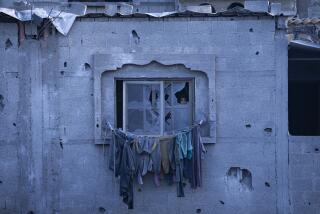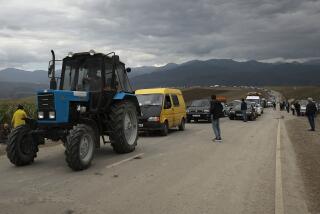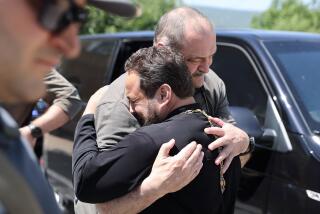Thousands of Armenians Mourn Azerbaijan Deaths : Soviet Union: Both sides point fingers as to what provoked the violence in which 36 people died.
- Share via
MOSCOW — Tens of thousands of Armenians flowed through the streets of their capital on Saturday, mourning victims of violence against their countrymen in neighboring Azerbaijan that their president called a premeditated pogrom against peaceful civilians by Kremlin troops.
“They died for their homeland, and thus they will live forever,” Galstyan Ambartsyum, the mayor of Yerevan, told a crowd gathered in Freedom Square, according to the Armenpress news service.
Red, blue and orange Armenian national flags flew at half-staff and a sea of Armenians lifted their fists into the air as they viewed the open coffins of three of the 36 Armenians killed last week, Artak Vartazaryan, director of Armenpress, said in a telephone interview.
“A huge column of people moved toward Freedom Square,” Razmik Khumaryan, a spokesman for the Armenian National Movement, said in a telephone interview. “All traffic in the downtown area was stopped because of the mourning procession.”
Armenian President Levon Ter-Petrosyan told reporters Saturday in Moscow that the Kremlin is responsible for the attack by Soviet troops and Azerbaijani special police. These forces, he said, “destroyed everything there was to be destroyed” in the villages of Getashen and Martunashen, which have Armenian populations but are located in Azerbaijan.
“The Soviet army and Interior (Ministry) troops carried out this pogrom,” Ter-Petrosyan said. “This is a completely new happening--this is a horrible precedent.”
According to Armenian reports, the village of Martunashen was burned to the ground and dozens of people are missing. Khumaryan said that 20 houses in Getashen were destroyed by cannon fire, and six doctors who had been flown in to treat the wounded were prevented by military guards from leaving the airstrip.
However, Azerbaijani and Soviet officials blame the violence on Armenian extremists resisting Azerbaijani rule.
The independent Assa news agency of Azerbaijan reported that Armenian terrorists had set fire to the homes of other Armenians who were preparing to flee Martunashen. It also said that Armenia is training volunteers to go to war with Azerbaijan and has already sent some units to the border region.
“All these measures are sanctioned and carried out by the Armenian government, which seems to be about to start a wide-scale combat against Azerbaijan,” Assa commented.
Armenian bandits were accused of stealing four armored vehicles and 45 submachine guns Thursday during an attack on Interior Ministry troops, according to the official Tass news agency. The Soviet Defense and Interior ministries, in a statement, also accused Armenian extremists of staging more frequent acts of “terrorism” against servicemen.
The statement made it clear that Soviet troops were ready to take more aggressive action against Armenians.
“The Armenian leadership and those who seek to kindle the conflict, using for this purpose provocative actions against servicemen, will bear full responsibility for the crimes committed and the possible tragic development of events,” the statement said. “In these conditions the Soviet Interior Ministry and Defense Ministry will be compelled to take all necessary steps to prevent the escalation of violence, stop extremist actions against servicemen and officers of law enforcement agencies.”
Strife between the pro-Soviet Azerbaijanis and the pro-independence Armenians has been the most intractable of the ethnic conflicts that have shaken the Soviet Union over the last few years.
Hundreds of Armenians and Azerbaijanis have been killed in three years of sporadic fighting, much of it over the disputed territory of Nagorno-Karabakh, an Armenian enclave within Azerbaijan.
In the first flare-up of ethnic tension between the neighboring republics in the Caucasus Mountains, 32 people were killed when a mob of Azerbaijanis stormed Armenian apartments in the Azerbaijani city of Sumgait in February, 1988. The other most publicized outbreak was an Armenian pogrom in the Azerbaijani capital of Baku in January, 1990.
“If the Sumgait and Baku tragedies can be called terror by crowds,” Ter-Petrosyan said, “then the Getashen tragedy is terror by the state.”
Ter-Petrosyan accused Azerbaijani President Ayaz N. Mutalibov of trying to deport Armenians from Azerbaijan with the consent and assistance of the Soviet Interior and Defense ministries. The deportation would be part of Armenia’s punishment for seeking independence from the Soviet Union, Ter-Petrosyan said. The Azerbaijani government has taken a pro-Kremlin stance.
“Deportation would mean a new spiral of escalation that would create unsolvable problems,” Ter-Petrosyan said. “We already have some results of it--the immense tension at the Armenian-Azerbaijani border.”
More to Read
Sign up for Essential California
The most important California stories and recommendations in your inbox every morning.
You may occasionally receive promotional content from the Los Angeles Times.










